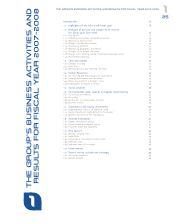Ubisoft 2007 Annual Report Download - page 36
Download and view the complete annual report
Please find page 36 of the 2007 Ubisoft annual report below. You can navigate through the pages in the report by either clicking on the pages listed below, or by using the keyword search tool below to find specific information within the annual report.
UBISOFT • FINANCIAL REPORT 2008
1.3.2 Cash flows
Video game publishers have two kinds of cash flows:
Cash flows from financing development costs are spread
out on a consistent basis over a period of 18 to 24
months, given that each project progressively scales up
but that the teams work on a number of projects. They
represented over €301 million in 2007-2008.
Cash flows from the marketing of games, are highly sea-
sonal (25% of revenue is generated in the first half of the
year and 75% in the second) and highlight a gap between
production costs and receipt of income. In fact, the
Company must first finance product manufacturing,
which accounts for 35% of revenue and which is payable
at 30 days on average, and also finance marketing costs
(around 12% of revenue) before receiving income at on
average 80 days after the games hit the shelves. For this
reason, the Company must finance significant cash peaks
around Christmas-time and sees its cash climb back up
during February and March. This timing may be different
if Q4 of the fiscal year is very strong, because in this
case, working capital requirements may be higher.
Accordingly, in fiscal year 2007-2008, the Company’s net
debt varied from (€148) million and €20 million, with the
high point of debt seen between November and January.
Borrowing terms
and financing
structure
During 2007-2008, most of the financing came from a
medium-term loan of €20 million. Ubisoft did not have to
use the €100 million syndicated loan signed in May 2005,
replaced by a €180 million syndicated loan in May 2008,
nor the bilateral bank credit facilities. On the other hand,
the Company placed surplus cash on a consistent basis.
Average cost of borrowings was 4.7%.
The covenants with which the Company must comply in
relation to the new syndicated loan as well as those for
the €20 million bilateral credit facilities signed in 2006-
2007 are as follows:
Furthermore, in 2006-2007, the Company signed a €10 mil-
lion line, which is subject to the same covenants but uses 0.9
for the net debt/equity ratio.
For fiscal year 2008-2009, and unless the Company makes a
major acquisition, Ubisoft should be able to finance its ope-
rations from cash and the various facilities made available to
it, including €210 million in confirmed credit facilities
(including €180 million from the Syndicated Loan signed in
2008) and €76 million from short-term facilities.
1.3.3
2008-2009 2007-2008
Net debt restated for assigned
receivables/equity
restated for goodwill < 0.80 0.85
Net debt restated for assigned
receivables/EBITDA < 1.5 1.5
Cash and capital
1.3
Changes in equity
The video games business line calls for investments on
development of around 30% of revenue. This capital
expenditure takes place over average periods of between
18 to 24 months, which publishers must be able to finance
out of their own resources. Furthermore, publishers are
required to launch new releases on a regular basis, the
level of success of which cannot be guaranteed.
For these reasons, significant capitalization is essential to
guarantee the continuous financing of capital expenditure
and to deal with contingencies stemming from the success
or failure of a particular title without endangering the
future of the Company.
With equity of €634 million, up €112 million, Ubisoft easily
finances its capital investments, which amounted to €301
million.
1.3.1
























